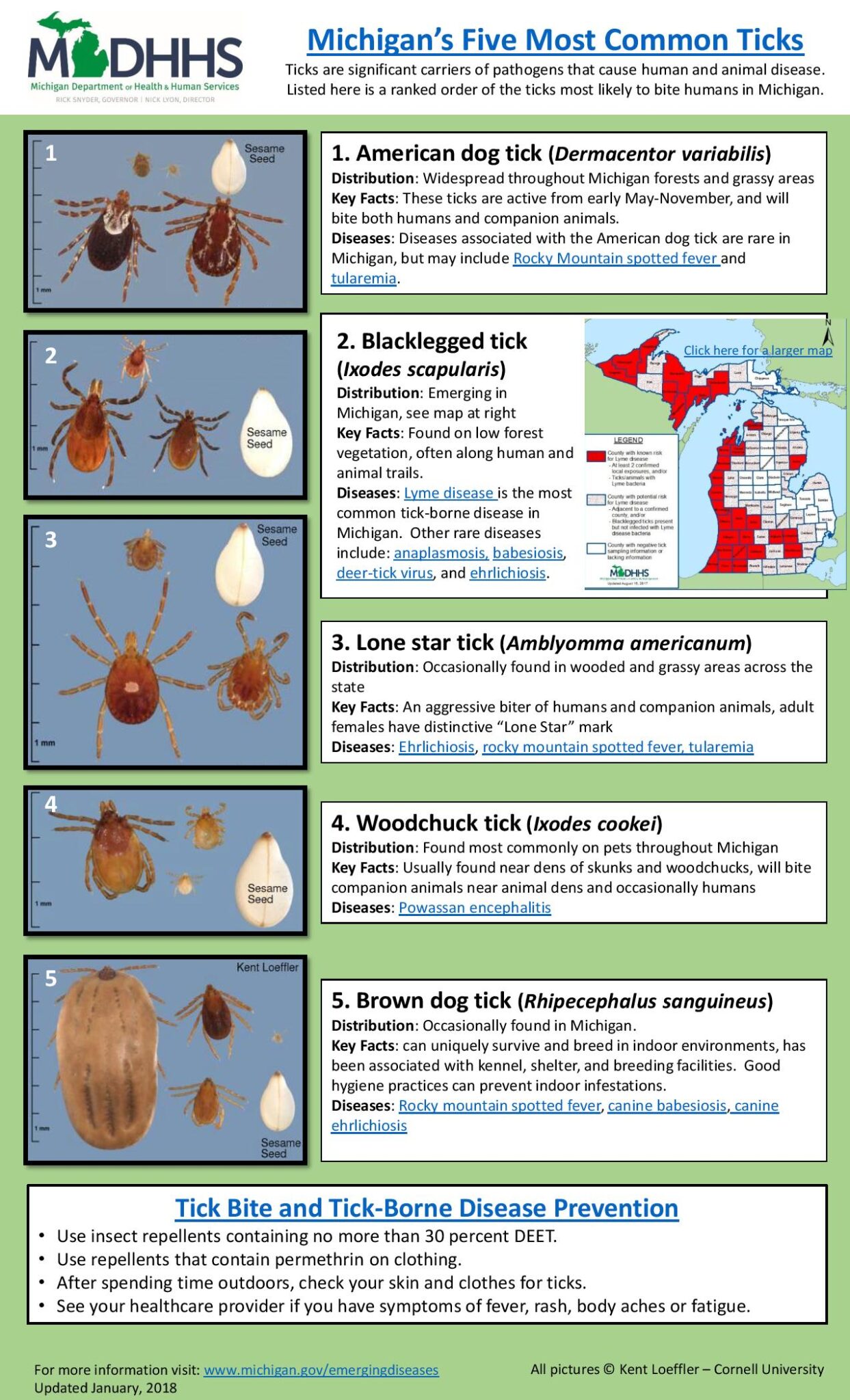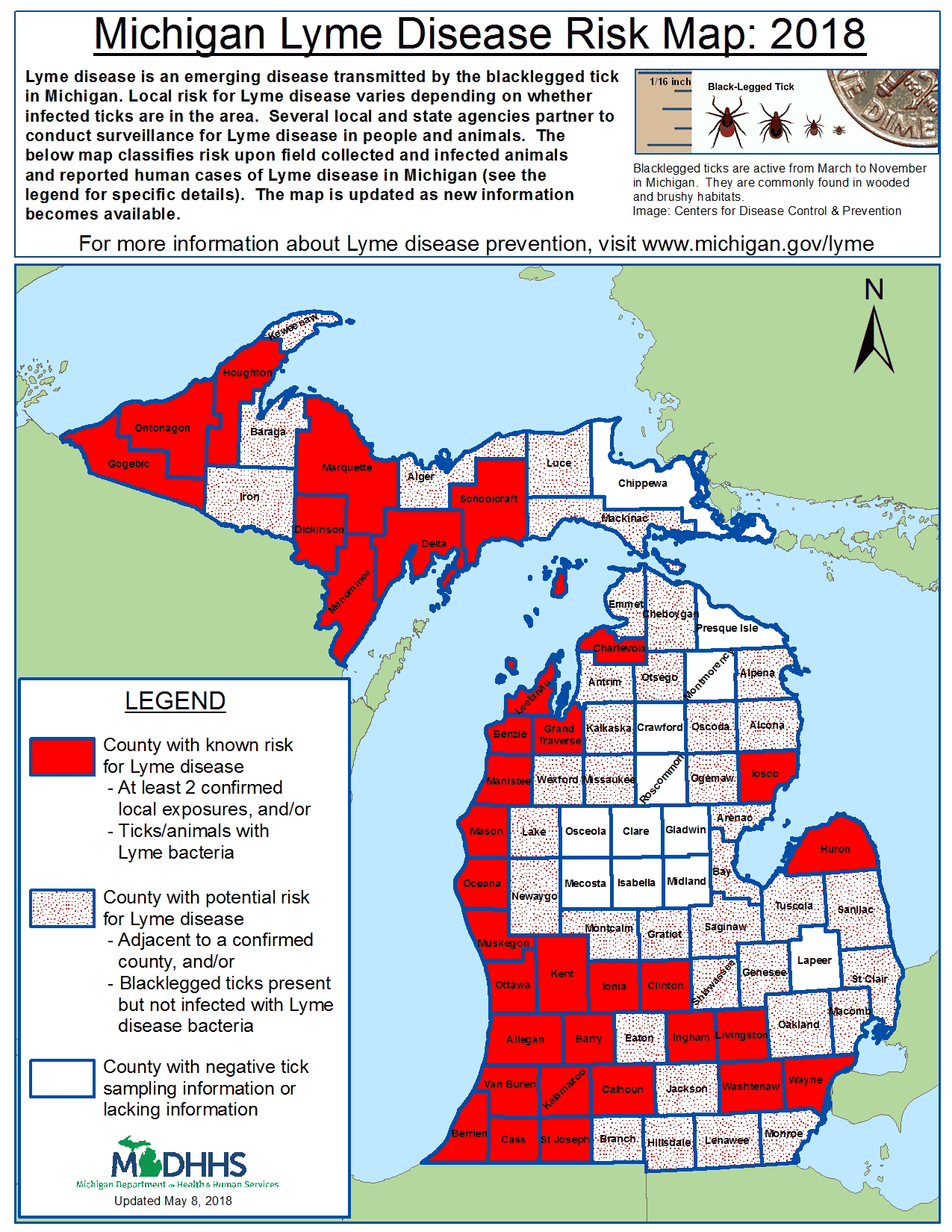by Rebecca Range, Veterinary Assistant
Tick season is in full swing in Washtenaw County, and the Ann Arbor Animal Hospital is pulling a lot of ticks off of dogs right now. Tick season in Michigan is typically in the warmer months from April to September. However, this year the hospital has pulled several ticks off of dogs as early as February, when the weather warmed up for a couple of days.
What is Lyme disease?
Lyme disease (Lyme borreliosis) is an illness transmitted through tick bites that affects both humans and animals. Lyme disease is caused by spiral shaped bacterium called Borrelia burdoferi that is transmitted from an infected tick.
Which type of ticks spread Lyme disease?
Blacklegged ticks (also known as Deer ticks) are an emerging species in Michigan and the only type of ticks found in Michigan that spread Lyme disease. Blacklegged ticks are small with black legs and a rounded black shield shaped plate behind their heads. These ticks can be found in grassy, wooded, and marshy areas. Dogs are most likely to be bitten by Blacklegged ticks in wooded and overgrown areas, but can even get bitten while playing in your backyard or walking around a suburban neighborhood. Although Blacklegged ticks are the only type that spread Lyme in Michigan, other types of ticks found in the Ann Arbor area can cause other harmful diseases. Here is a list of the 5 most common ticks found in Michigan and the diseases they potentially carry.

Can my dog get Lyme disease in Washtenaw County?
In the past decade, there have been known cases of Lyme disease in Washtenaw County, but this past year experts have determined that individuals have contracted Lyme disease from local ticks without leaving the county. There were 17 confirmed cases of Lyme disease in Washtenaw County in 2016 and that number is expected to rise. In addition, Blacklegged ticks in Waterloo and Pinckney State Recreation Areas have tested positive for Lyme. Given this increase, Washtenaw County has been upgraded from having potential risk for Lyme disease to now having known risk for Lyme disease. MLive has more coverage on the status of Lyme in Washtenaw County.

This map of Michigan shows the spread of Lyme disease by county. Washtenaw was recently upgraded from potentially having Lyme to being a known risk for Lyme. Image by MDHHS.
If you have concerns about a tick, you can bring it in to be identified. The state of Michigan has a program to identify ticks, and a live Blacklegged tick can be sent in to be tested for Lyme. More information about submitting and identifying ticks can be found on the state of Michigan’s website.
How does Lyme disease affect dogs?
Dogs infected with Lyme disease may not show symptoms for up to 2-5 months after a tick bite. Other dogs may remain asymptomatic despite Lyme exposure. Typical symptoms include fever, weight loss, loss of appetite, lameness, joint swelling, and decreased activity. Recurrent lameness is possible, extremities may be tender, and joint inflammation can last for days to weeks. Lyme disease is diagnosed through a blood test that shows whether an animal has been exposed to the bacterium. Your veterinarian can then create a treatment plan and provide supportive care if your dog is Lyme positive and showing symptoms. More information about Lyme disease in dogs can be found on the AVMA website.
How can I help protect my dog from ticks?
The best protection against Lyme disease is preventing tick bites in the first place with monthly flea and tick prevention. Monthly heartworm preventives (e.g. Heartgard, Interceptor Plus, Sentinel) do not protect against ticks, so additional flea and tick prevention is needed for tick control. For oral tick prevention we recommend Simparica for dogs over 6 months of age and Nexgard for puppies 2-6 months of age. If you prefer a topical product, we recommend Effitix as a flea and tick repellent for dogs. The oral preventives work by killing the tick when it bites, which may leave behind a dead, dried up tick, but orals provide excellent protection through the end of the month without washing off. Topical preventives work by repelling ticks, so you avoid dried up ticks, but this may result in a live tick falling off your dog in your house or car where you may come into contact with it. Topical preventives can also have reduced efficacy after baths and swimming.
In addition to monthly flea and tick preventives, we offer a Lyme vaccine. The Lyme vaccine is most often given to dogs that travel to the East Coast, the Upper Midwest, Western Michigan, and other areas where Lyme disease is most prevalent. Discuss with your veterinarian if vaccinating for Lyme is appropriate for your animal depending on your pet’s travel plans, general health, and lifestyle. The protocol for the Lyme vaccine is an initial vaccination followed by a booster 2-4 weeks later and an annual booster after that. The Lyme vaccine does not replace monthly flea and tick prevention.
You can also protect your dogs by avoiding walking in densely vegetated areas where ticks thrive. Ticks looking for a host typically hang 6-18 inches above the ground, so keeping your yard clear of dense shrubbery and tall grass can help reduce the tick population in your area. Also make sure to check both your animals and yourself daily for ticks when coming inside.
How do I remove a tick?
If you find a tick on your dog, you should remove the tick as soon as possible. The goal is to remove the entire tick whole, which usually includes a tiny piece of skin that gets pulled off by the tick’s mouth. Do not attempt to remove a tick with your fingers, and always wear gloves to protect yourself from the blood and fluids. Blunt tweezers or plastic tick removers work well and are more successful at removing the tick whole. At the hospital, we often use the Tick Twister, a plastic tool that is designed with special prongs to fit on either side of the tick so you just have to pull and twist upward for the whole tick to come out. The site of tick removal may have a firm swelling for a couple weeks after the tick has been removed. More information about removing ticks can be found on the American Kennel Club website.
Recent Posts
About Us
Ann Arbor Animal Hospital is a locally-owned animal hospital operating for over 90 years in Ann Arbor, MI.
